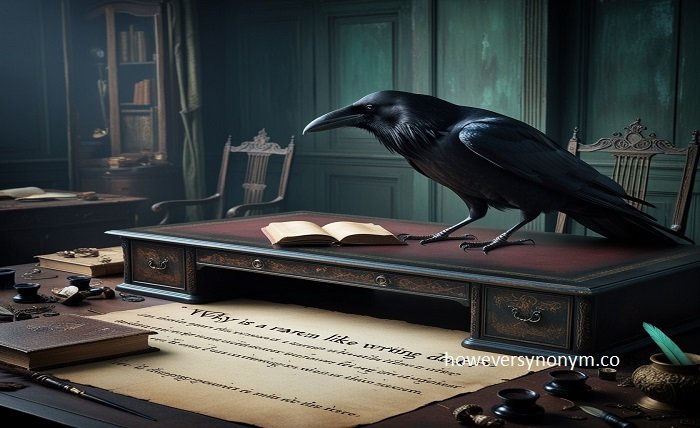Introduction
In literature, one of the most persistent and perplexing puzzles is “why is a raven like a writing desk?” Written by Lewis Carroll’s “Alice’s Adventures in Wonderland,” the Mad Hatter poses this conundrum, which has baffled readers and academics alike since the book’s release in 1865. Not only is it difficult to come up with a response, but it’s also difficult to comprehend why this subject has held people’s attention for so long. We’ll look at the riddle’s history, various interpretations, and current fascination in this blog article.
The Origin of the Riddle
The well-known story “why is a raven like a writing desk’s Adventures in Wonderland” by Lewis Carroll contains the first mention of the riddle. It is not meant to be solved—Carroll himself acknowledged that it was meant to be absurd—but the Mad Hatter presents it during the tea party scene. The lack of a response emphasizes the world of the novel’s joyful absurdity, where rationality is subverted.
Initial Responses and Solutions
Many explanations and answers to the puzzle have surfaced over time, illustrating the various approaches that readers take to the task. A common solution connects the puzzle to Edgar Allan Poe’s poem “The Raven,” implying that elements of reflection and melancholy are represented by both the writing desk and the raven. The premise that both objects—the writing desk when devoid of thoughts and the raven when plucked—have “nothing in them” is the basis for another interpretation. Though Carroll intended to give a dilemma with no obvious solution, these answers demonstrate the riddle’s capacity to elicit innovative and diverse thought processes.
The Riddle’s Cultural Impact
The why is a raven like a writing desk has had a profound effect on popular culture, inspiring a variety of literary and creative creations. Its lightheartedness has prompted literary, film, and television adaptations, proving its adaptability and enduring appeal. Due to the riddle’s ability to pique people’s interest and stimulate innovation, it has been incorporated into contemporary stories and artistic endeavors, demonstrating how viewers continue to be enthralled and motivated by it in a variety of media.
The Psychological Aspect
From a psychological perspective, the riddle appeals to our natural tendency to look for patterns and significance in situations that don’t make sense. Even in disorderly or irrational situations, the human brain is wired to look for patterns and answers. The why is a raven like a writing desk’s capacity to pique our interest in problem-solving and pushing the limits of reasoning is shown in our fascination with it. It emphasizes the psychological allure of intellectual problems of this kind by pushing us to think beyond the box and to explore the possibilities of finding meaning in the ridiculous.
The Riddle in Education
The riddle is an effective technique for encouraging creativity and critical thinking in educational settings. Students can investigate ideas about language, logic, and the nature of questions and answers by working with the riddle. Because the riddle is open-ended, students are encouraged to think creatively and recognize the value of absurdity in the process of intellectual inquiry. As such, it turns into an effective teaching tool for encouraging greater comprehension and why is a raven like a writing desk students’ intellectual curiosity.
Literary References and Adaptations
The why is a raven like a writing desk enduring influence on literature is demonstrated by the plethora of literary allusions and adaptations that it has inspired. The topic of riddles is resurrected in Lewis Carroll’s follow-up, “Through the Looking-Glass,” which delves more into the nature of questions and answers. Themes from the riddle have been incorporated into the works of other writers and artists, proving the riddle’s influence on literary traditions and capacity to spark originality in a wide range of genres and forms.
Modern Interpretations
why is a raven like a writing desk viewpoints are frequently combined with conventional analysis in contemporary interpretations of the riddle. Some contemporary academics, for example, analyze the puzzle in light of existentialist theory or cognitive science, investigating its connections to ongoing philosophical discussions and advances in science. The aforementioned interpretations demonstrate the riddle’s continued significance and its ability to interact with changing intellectual and cultural environments.
The Riddle’s Legacy
The why is a raven like a writing desk’s lasting significance comes from its capacity to go beyond its historical setting and hold true for all ages. It makes us reevaluate how we understand meaning and reasoning and pushes us to consider their true natures. The riddle’s lighthearted and provocative style emphasizes literature’s timeless ability to arouse intellectual curiosity and inspire it, guaranteeing its presence in the cultural and intellectual landscape for years to come.
Conclusion
One of the most fascinating and perplexing issues in literature is still “Why is a raven like a writing desk?” Despite Lewis Carroll’s intention for it to be a humorous piece of nonsense, it has had a significant impact. The puzzle asks us to consider the nature of absurdity and logic, questions and answers. It pushes us to value the joyful aspect of intellectual research and to find meaning in the seemingly meaningless. Wordplay, philosophical contemplation, or cultural adaptation—the riddle’s allure and inspiration never fade.
FAQ
What was Lewis Carroll’s original intention with the riddle?
The original plan of Lewis Carroll was to write some whimsical gibberish. The purpose of the riddle was to be humorous and nonsensical, with no clear solution.
Have any definitive answers to the riddle been widely accepted?
No, there isn’t a generally acknowledged, conclusive solution to the puzzle. There exist a number of interpretations, but none are accepted as the “correct” answer by .read about more disney lorcana walmart.
How has the riddle been used in educational contexts?
The riddle is frequently used in educational settings to promote creativity and critical thinking. It is a tool for investigating language, logic, and the structure of questions and responses.

